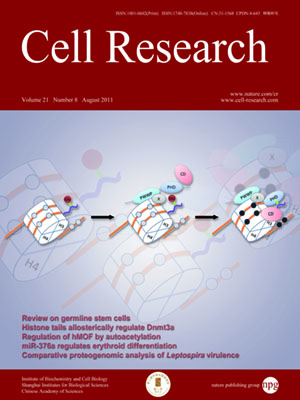
Advanced Search
Submit Manuscript
Advanced Search
Submit Manuscript
Volume 21, No 8, Aug 2011
ISSN: 1001-0602
EISSN: 1748-7838 2018
impact factor 17.848*
(Clarivate Analytics, 2019)
Volume 21 Issue 8, August 2011: 1172-1181
Bin-Zhong Li1,2,*, Zheng Huang1,2,3,*, Qing-Yan Cui1,2, Xue-Hui Song1,2, Lin Du1,2, Albert Jeltsch3, Ping Chen4, Guohong Li4, En Li5 and Guo-Liang Xu
2The Graduate School, Chinese Academy of Sciences, 320 Yueyang Road, Shanghai 200031, China
3Biochemistry Laboratory, School of Engineering and Science, Jacobs University Bremen, Campus Ring 1, Bremen 28759, Germany
4Institute of Biophysics, Chinese Academy of Sciences, 15 Datun Road, Beijing 100101, China
5Novartis Institute of BioMedical Research, 898 Halei Road, Shanghai 201203, China
Correspondence: Guo-Liang Xu,(glxu@sibs.ac.cn)
Cytosine methylation of genomic DNA controls gene expression and maintains genome stability. How a specific DNA sequence is targeted for methylation by a methyltransferase is largely unknown. Here, we show that histone H3 tails lacking lysine 4 (K4) methylation function as an allosteric activator for methyltransferase Dnmt3a by binding to its plant homeodomain (PHD). In vitro, histone H3 peptides stimulated the methylation activity of Dnmt3a up to 8-fold, in a manner reversely correlated with the level of K4 methylation. The biological significance of allosteric regulation was manifested by molecular modeling and identification of key residues in both the PHD and the catalytic domain of Dnmt3a whose mutations impaired the stimulation of methylation activity by H3 peptides but not the binding of H3 peptides. Significantly, these mutant Dnmt3a proteins were almost inactive in DNA methylation when expressed in mouse embryonic stem cells while their recruitment to genomic targets was unaltered. We therefore propose a two-step mechanism for de novo DNA methylation – first recruitment of the methyltransferase probably assisted by a chromatin- or DNA-binding factor, and then allosteric activation depending on the interaction between Dnmt3a and the histone tails – the latter might serve as a checkpoint for the methylation activity.
de novo DNA methylation; Dnmt3a; Histone H3 tail; PHD domain; allosteric stimulation